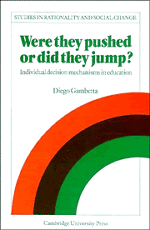Book contents
- Frontmatter
- Contents
- Preface
- List of figures
- Introduction
- 1 THE THEORETICAL QUESTION
- 2 INSTITUTIONAL CONSTRAINTS AND EDUCATIONAL CHOICES
- 3 WERE THEY PUSHED?
- 4 OR DID THEY JUMP?
- Conclusions
- Appendix 1 The high school pupils survey
- Appendix 2 The youth unemployment survey
- Appendix 3 Independent variables
- Appendix 4 Logit models: summary tables
- References
- Index of names
2 - INSTITUTIONAL CONSTRAINTS AND EDUCATIONAL CHOICES
Published online by Cambridge University Press: 07 May 2010
- Frontmatter
- Contents
- Preface
- List of figures
- Introduction
- 1 THE THEORETICAL QUESTION
- 2 INSTITUTIONAL CONSTRAINTS AND EDUCATIONAL CHOICES
- 3 WERE THEY PUSHED?
- 4 OR DID THEY JUMP?
- Conclusions
- Appendix 1 The high school pupils survey
- Appendix 2 The youth unemployment survey
- Appendix 3 Independent variables
- Appendix 4 Logit models: summary tables
- References
- Index of names
Summary
In chapter 1 three approaches to individuals’ decisions were outlined and it was argued that although the intentional view is in principle the most important, external constraints and non-rational forces can also be expected to affect educational choices. Before trying to develop those three approaches empirically through the analysis of the survey data and to focus on individuals’ mechanisms of decision, it is necessary to introduce the present institutional context of Italian education and the educational choices which it makes available to individuals. The latter constitute the ‘dependent variable’ of this study. This task, to which this chapter is devoted, requires a few words of introduction.
In general an educational system constitutes an external constraint on individual behaviour, in the sense that it provides the organization for a given type of education and sets the rules and the procedures which regulate admission, selection, certification and so on. Single individuals, when making a decision, have to adjust to the institutionally feasible set of alternatives that the system offers and, depending on how an educational system is set up and its streaming and selecting mechanisms arranged, individuals may face considerably different routes. For example, during term-time few British university students can seriously consider the idea of a job, whereas in Italy many students do work simultaneously.
- Type
- Chapter
- Information
- Were They Pushed or Did They Jump?Individual Decision Mechanisms in Education, pp. 30 - 60Publisher: Cambridge University PressPrint publication year: 1987



